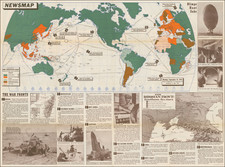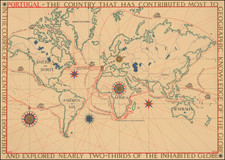Rare, Highly Decorative Double Hemisphere Map of the World
This stunningly-decorated double hemisphere world map is a very rare find. Based on the famous Jodocus Hondius 1617 world map, this map was engraved by Henri Le Roy in Paris and published by Michel Van Lochem.
The Hondius map was the first to feature the findings of the Le Maire and Schouten circumnavigation (1615-1617), which included the Straights of Le Maire. It was also the earliest to show Hudson's Bay and the full course of the St. Lawrence, albeit in a curious configuration.
This map is highly embellished, with smaller celestial double hemispheres at center of the map frame and illustrative vignettes at each corner representing the animals and people local to each of the known continents. Europe is represented by a horse and reindeer, Africa by an elephant, the Americas by a crocodile, and Asia by a camel.
Across both hemispheres, sailing vessels wander across the Pacific and Indian oceans, and numerous fantastical sea creatures can be seen surfacing from the ocean depths. Flying fish can be spotted off the southern African coast, and a native sailing vessel is depicted near Tierra del Fuego.
The map contains three decorative cartouches. The cartouche in America details its discovery by Columbus in 1492 and subsequent denomination after Amerigo Vespucci’s exploration in 1499. The large cartouche on the western hemisphere side of Terra Australis Incognita details the numerous explorations undertaken to discover unknown lands, including North America and Oceanus Tartaricus, north of Asia on this map. The cartouche located on the eastern hemisphere side of Terra Australis Incognita contains publication information for Michel Van Lochem. Henri Le Roy and Michel Van Lochem’s attributions are visible along the bottom border.
Discoveries of Jacob Le Maire and Willem Schouten
The source map for this work, Hondius’ 1617 world map, was the first to show the straits around Cape Horn and the islands in the Pacific discovered by Jacob Le Maire and Willem Schouten’s voyage (1615-1617). Their circumnavigation was meant to undermine the trade monopoly of the Dutch East India Company (VOC). The Straits of Le Maire marked a new passage into the Pacific that avoided the Strait of Magellan, which was the exclusive purview of the VOC. The place names around the Straits of Le Maire include: Cape Hoorn, Cape Mauritius, the van Barnevelt Islands, and Staten lant. These were all named by Schouten and Le Maire upon their discovery of the area. This voyage was also pivotal for showing that Tierra del Fuego was not a continent as had been previously believed.
The islands and atolls depicted north of Terra Australis Incognita reflect the names given by the Le Maire – Schouten expedition. Their expedition encountered those places in Polynesia en route to the Moluccas, skirting New Guinea and New Ireland (as evidenced by Groene Eylanden and S. Ians Eylant on this map) along the way. The islands named after Schouten are also included on this map, located just north of New Guinea.
Henry Hudson and John Davis in North America
Hondius’ map was also one of the first to depict Hudson’s. An early conception of the St. Lawrence river is also shown, flowing west across most of North America. John Davis’ strait is depicted here, accompanied by the typical annotation that he was forced to turn back by ice. Davis’ discovery of what is today known as Baffin Island, although unfinished, is also marked on the map.
The unknown southern continent: Terra Australis Incognita
This mythical landmass was commonly referred to as variants of Magellanica, named after Ferdinand Magellan, Terra Australis Incognita, in the tradition of Ptolemaic maps, and the Unknown Southern Land. Here, it is referred to in the Ptolemaic tradition.
In antiquity, Greco-Roman scholars and cosmographers such as Ptolemy posited that the Indian Ocean was enclosed by land, and that the continents of the globe should be balanced, in that the amount of land found in the Northern Hemisphere should also exist in the Southern Hemisphere. Ferdinand Magellan’s 1520 discovery of Tierra del Fuego was thought to support claims of a southern continent, and many prominent mapmakers, including Gerard Mercator, strongly believed in the continent’s existence. This idea of a sprawling southern continent was included on European maps for centuries but was eventually disproven by James Cook’s first (1768) and second (1772) voyages through the southern Pacific.
The place name Beach can be found at the tip of the southern continent in Southeast Asia, a toponym which first originated with a misreading of Marco Polo’s travel accounts. Marco Polo described the land as containing many riches, which explains the map’s annotation claiming the area to be abundant in spices. To the east of Beach, Mare Lantchidol is similarly an inaccurate transcription of the Malay-Javanese term ‘Laut Kidul’ (South Sea), which also stems from Marco Polo’s accounts.
America’s myths: Nova Albion, cities of gold, and El Dorado
Sir Francis Drake’s fabled Nova Albion is placed in a prominent, conjectural northwestern coast of North America. This massive coast appears to stretch uninterrupted to Asia, where it is separated by only the Straits of Anian. The name Anian derives from Ania, a Chinese province on a large gulf mentioned in The Travels of Marco Polo. The gulf Polo described was actually the Gulf of Tonkin, but due to misreading the province’s description was transposed from Vietnam to areas much farther north.
Quivira and Cevola in North America refer to the fabled Seven Cities of Gold sought by the Spanish explorer Francisco Vasquez de Coronado in 1541. Although Coronado did not prove their existence, names associated with the Seven Cities of Gold remained popular toponyms on early renderings of North America.
In South America, the fabled L[ake] Parime and city of Manoa (El Dorado) are shown near Guiana. Manoa and Lake Parime (also known as Parima) were first identified by Sir Walter Raleigh in 1595 after he observed indigenous traders from the Manoa nation carrying gold and assumed they came from the mythical city of gold, El Dorado.
The map was separately published, as well as featured in Les Cartes Générales, published in 1637 and 1640 by Nicolas Tassin. It was also included Pierre d’Avity’s Le Monde of 1643.
This map’s particular rarity on the market makes it an exceptional choice for collectors. We have noted just two examples of this work in the past twenty years. It is a sublimely decorated, noteworthy addition to any collection.









![[Early Photographic Facsimile of the Lopo Homem Planisphere of 1554]](https://storage.googleapis.com/raremaps/img/small/67276.jpg)

![La Sphere Artificielle . . . 1740 [Terrestrial, Celestial & Armillary Globes]](https://storage.googleapis.com/raremaps/img/small/80300.jpg)
![[ World Map Facsimile ] Typus Universalis Terrae, Iuxta Modernorum Distinctionem et Extensionem Per Regna et Provincias](https://storage.googleapis.com/raremaps/img/small/95596.jpg)
![Historiarum Indicarum Libri XVI [with:] Indiarum Orientalium Occidentaliumque Descriptio. Pet. Maffei Historiae Harum Verissimae, Dedicata.](https://storage.googleapis.com/raremaps/img/small/102793.jpg)
